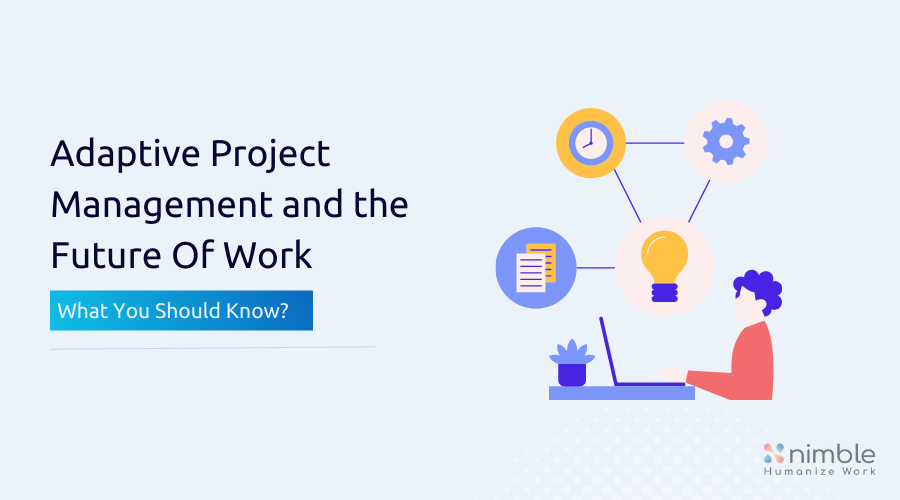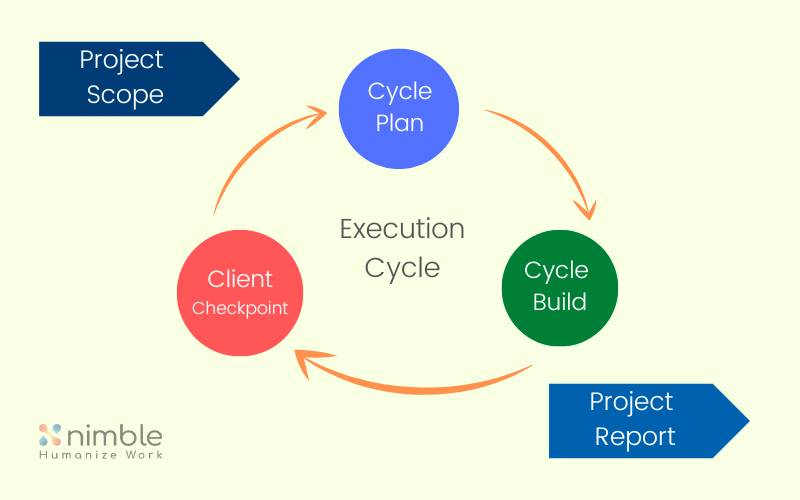- Why Nimble?
- Products
_____________________
- Solutions
- Customers
- Resources
- Login
- Try Nimble for Free
- Why Nimble?
- Products
_____________________
- Solutions
- Customers
- Resources
- Login
- Try Nimble for Free
Navigate to
Adaptive Project Management and the Future Of Work: What You Should Know
- 10 mins read
- By Laurent Duperval

Adaptive project management is not just another buzzword. It’s become essential to lead successful projects.
If November 2022 has reminded us of anything, it’s that disruption to business comes unexpectedly. That month coincided with the introduction of ChatGPT in the marketplace.
Consider the potential impact of this democratization of generative AI on business. What used to take one week for a person to do can now happen in a few hours or a few minutes.
It’s a mirror image of how things can change quickly within a company and affect the progress of a project. Today, more than ever, adapting to the increasing pace of change is essential. That’s where adaptive project management shines.
Table of Contents
What is Adaptive Project Management?
Adaptive Project Management (APM) is a flexible approach to managing projects. Traditional project management methodologies often rely on rigid plans and predefined processes. It makes it difficult to change course rapidly when the project environment changes.
Adaptive project management assumes conditions will change throughout a project’s lifecycle. There is no expectation that a project will adhere to fixed scope, time, and resources.
Instead, it embraces flexibility, continuous improvement, and adaptability. APM is especially effective for projects that must navigate uncertain or volatile environments.
Let’s contrast it with two other project management approaches: predictive and iterative.
Predictive Project Management
This is typically called the waterfall approach because of its sequential and linear nature. It requires thorough upfront planning and a clear definition of project requirements.
Waterfall projects include contingency measures to address potential risks. However, to be successful, there should be few adjustments to the initial plans.
Waterfall was once considered THE project management methOd. Today, companies favor more flexible approaches.
According to ProjectManager.com, only 14% of projects were strictly waterfall. 69% did not use waterfall or used waterfall in combination with other methodologies.
The reason is simple: in today’s business reality, change is too frequent and too fast to predict the future. You must adapt.
Nevertheless, predictive project management can work well for projects with stable requirements, predictable outcomes, and limited scope changes.
Iterative Project Management
Iterative project management is similar to adaptive, using continuous improvement and feedback loops.
Project phases are broken down into smaller, achievable chunks or iterations. Teams learn from earlier steps and use that knowledge to improve future iterations. They focus on incremental results to deliver ongoing benefits and more successful outcomes.
This approach is ideal for projects where the end state is unclear and can be refined over many iterations. It requires regular and frequent planning and goal reassessment. Many software development teams use it in the form of Scrum, for example.
Iterative project management has proven to be much more successful than predictive project management. The Standish Group CHAOS report from 2015 (the last published results) showed a marked difference in success rates:
The Adaptive Project Management Approach
Adaptive project management works best when innovation and creativity are essential to success. Projects with changing requirements, especially, can benefit. It assumes nothing is set in stone.
Requirements will change, and so will resources (money and people), market conditions, and technology. To succeed under such conditions, project teams must embrace change, learn from mistakes, and adjust plans as client expectations change.
APM encourages:
1. Flexibility: Adapting quickly and efficiently can be the difference that makes a project succeed and meet a clients satisfaction.
Flexibility is built into the DNA of adaptive project management. It ensures that teams can meet the challenges of any significant change at any time.
2. Collaboration: APM encourages and fosters teamwork and close communication among stakeholders—especially clients.
Teams don’t work in silos for weeks or months on end only to deliver a solution that doesn’t meet the clients needs.
3. Iterative improvement: Once the project is over, it’s too late to start thinking about what could have gone better. That introspection has to occur during the project when all the stakeholders are invested in the process and motivated to do things more effectively.
APM encourages all project members to refine and improve processes and deliverables continually.
4. Risk management: At the start of a project, it’s practically impossible to identify all the risks. And as the project advances, new risks emerge because of changing business conditions.
Identifying and addressing risks proactively becomes an essential part of delivering a successful project.
If that sounds like Agile, it’s because Agile informs many of the processes around APM. However, it encompasses more than Agile.
Adaptive Project Management vs. Agile
Although the heading says “vs.”, Agile and APM are not at odds with each other. Adaptive project management shares several core principles with Agile. It differs in scope, application, and terminology.
Scope
APM isn’t bound to any specific framework or set of principles, and companies can adapt it to suit their needs.
Agile is a subset of adaptive project management. It includes specific methodologies and practices, such as Scrum and Kanban.
Application
APM’s flexibility means it can apply to many types of projects, industries, and domains—not just software development. It’s well suited to projects in highly uncertain environments.
Agile is often associated with software development. However, the principles and practices have been adapted to many other domains.
Terminology and practices
Adaptive project management doesn’t prescribe specific terminology, roles, or practices. Instead, it can be tailored to the needs of individual projects and organizations.
Furthermore, when many teams are involved in the project, each team can use the approach that best suits their reality.
Agile often includes well-defined roles (Scrum Master, Product Owner), terminology (user stories, sprints, and velocity), and practices (stand-ups, retrospectives, and backlog refinement).
These specific terms help create a common language and structure for Agile teams.
In its simplest terms, APM can be viewed as a strategic approach to managing projects. Agile, with its close links to software delivery, has a more operational focus.
When to consider Adaptive Project Management?
Most companies can benefit from adaptive project management, especially when they know where they want to go, but don’t know how to get there. It can be ideal in these situations:
• High uncertainty: There is significant uncertainty about the project requirements, goals, or environment. Adaptive project management allows teams to remain flexible and adjust to new information.
• Rapidly changing environment: When market conditions, technology, or customer preferences evolve rapidly, APM allows companies to react quickly and pivot as needed to stay competitive.
• Complex projects: APM can help manage projects with multiple interdependencies or numerous stakeholders.
• Incremental value delivery: APM helps prioritize features to accommodate customer feedback and changing priorities. This can benefit projects where delivering small incremental value is better than waiting for a final product.
• Innovation and experimentation: When a project explores new ideas, technologies, or processes, adaptive project management lets teams test hypotheses and adjust their approach based on the results.
• Limited knowledge or experience: If a project ventures into an unfamiliar territory or new technologies, adaptive project management allows for course corrections as the team gains experience and insights.
• Labor shortages: Many project management approaches expect a given labor pool to be available when needed. APM enables project teams to adapt to the fluctuating availability of people.
If you want to implement adaptive project management, where should you start? The ideal place is the Adaptive Project Framework.
Understanding the Adaptive Project Framework (APF)
The Adaptive Project Framework (APF) is designed to handle changing requirements effectively when the project’s scope, business needs, or other factors evolve during project execution. The framework contains five stages:
1. Project scope or version scope: The project teams determine and agree on a high-level project scope with the customer at the beginning.
The scope also defines the length of the execution cycle. This sets the course for collaboration and ensures everyone has the same expectations. As part of the scope, the following are produced:
• The Condition of Satisfaction (CoS): This is a negotiated agreement with the client. It identifies the conditions to meet for them to be satisfied with the project outcome.
• The Project Overview Statement (POS): A one-page summary of the project in terms of the problem/opportunity, goal, objectives, success criteria, and risks.
• The Requirements Breakdown Structure (RBS) and Work Breakdown Structure (WBS): The RBS documents what the client needs. The WBS documents what the teams need to execute.
2. Cycle plan or cycle schedule: This is the start of the execution cycle. The teams determine the work to complete during the cycle.
Each team involved in the project builds its own micro-project to complete by the end of the execution cycle.
3. Cycle build: Teams do the work assigned to them during planning. This cycle involves regular monitoring and review of ongoing progress.
The cycle is a fixed duration and never changes. If teams can’t complete scheduled work during the allotted time, the incomplete tasks are moved to the next cycle. If the project requires changes, they are logged to be reviewed in the next cycle plan.
4. Client Checkpoint: This is the end of the execution cycle. The teams and the client review the work delivered in terms of functionality, quality, and meeting the expected value.
If the project is incomplete, the execution starts again at the cycle plan stage. The execution cycle continues until the Conditions of Satisfaction are met or the time and budget allocated have been spent.
5. Final report or post-version review: Once the conditions for repeating the execution cycle are met, the project teams and the client do a final review of the project.
At this stage, the client determines if the project met the desired outcome. As part of this last step, the teams and the client identify lessons learned that can improve APF for the next project.
If you use Scrum, APF will seem familiar. But APF doesn’t prescribe any particular project management approach. In fact, as part of the execution cycle, development teams can use Scrum, and other teams can use Kanban or another method that suits them better. The main benefits of AFP reside in the process, not the specific approach used.
Do you need Adaptive Project Management?
The good news is you probably use adaptive project management, even if it doesn’t go by that name. If you use Scrum in software development or other methodologies like Lean, Kanban or SAFe, you’ve already done some of the groundwork.
If you want to extend adaptive project management to the rest of your organization, consider the following factors:
• Volatility: Do you often face rapid and significant changes during your projects?
• Uncertainty: Are project outcomes hard to predict? For example, generative AI has had an immediate impact. However, it’s difficult to determine what it is now, or the long-term effects.
• Complexity: Do your projects involve many interacting components, where the results of those interactions are hard to predict?
• Ambiguity: Can your project environment be interpreted in more than one way? For example, if a competitor appears on the scene, is that good or bad? It can be good because it shows there is a market for your product. On the other hand, that’s one more competitor you may not want!
• Organizational Culture: Does your company have a culture of collaboration, open communication, and willingness to embrace change? Risk-averse or heavily siloed companies may find it challenging to adopt.
• Stakeholder Involvement: Are your stakeholders actively engaged throughout the project lifecycle? If they can’t or don’t want to participate in ongoing decision-making, it might not be the right fit.
If you answer yes to two or more questions, and your current methodology isn’t giving the results you want, take a closer look at adaptive project management.
APM’s flexibility can offer a significant advantage, as it’s best suited to projects where traditional methodologies struggle to manage VUCA environments.
Furthermore, although adaptive project management applies to projects, primarily, it can extend to many other parts of a business.
The future of Adaptive Project Management
Automation and AI. Cost increases. More demands from employees, clients, and shareholders.
These factors affect project outcomes significantly and show how APM’s flexibility provides major benefits for project management.
The focus on flexibility, collaboration, and iterative improvement can also lead to improvements in other business operations.
Adaptive Change Management
Change occurs swiftly and often without warning. Adaptive change management allows companies to respond quickly to new circumstances.
They can adjust their change process as new information becomes available. This results in more resilience when faced with the unexpected and more chances to take advantage of new possibilities.
Adaptive Work Management
People used to do the same job for 35 years and see little change between what they did at the start of their career and the end of it. Today, employees are asked to change roles many times during their career … if not their week or day.
Adaptive work management helps companies adjust their work priorities as business changes. As a result, they increase productivity, competitiveness, and employee engagement.
Adaptive Leadership
Adaptive leaders help employees and organizations deal with challenges and rapid change. They make employees feel more confident to express their ideas and embrace difficult tasks.
As a result, the whole organization becomes stronger and more capable of handling whatever lies ahead.
That’s just a start. Just as it’s impossible to predict the future for projects, it’s impossible to predict where APM’s effect will reach.
Adapt and Success Will Follow
More than ever, we are living in a VUCA world: volatile, uncertain, complex, and ambiguous.
And there are no signs that things will slow down anytime soon.
The advent of generative AI for all means the pace of change will increase in all domains and all industries. To survive, companies will need to meet those changes just as quickly.
Adaptive project management will be part of the solution.
Where do you start?
If you are using Agile methodologies for only a few projects in your company, start there, because Agile is at the root of APM.
Understand what, in your corporate culture, may be preventing you from embracing an approach that makes it easier to adapt to change.
If you are using Agile already, but in a limited fashion, see how you can extend it to other parts of your business.
Adopting adaptive project management throughout your company will allow you to make bolder decisions faster and with more confidence.
And as you know, fortune favors the bold.
Author:





